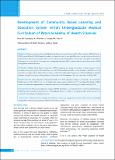Please use this identifier to cite or link to this item:
https://hdl.handle.net/20.500.14356/1737| Title: | Development of Community Based Learning and Education system within Undergraduate Medical Curriculum of Patan Academy of Health Sciences |
| Authors: | Baral, K P Upadhyay, S K Bhandhary, S Gongal, R N Karki, A |
| Citation: | BaralK. P., UpadhyayS. K., BhandharyS., GongalR. N., & KarkiA. (2016). Development of Community Based Learning and Education system within Undergraduate Medical Curriculum of Patan Academy of Health Sciences. Journal of Nepal Health Research Council. https://doi.org/10.33314/jnhrc.v0i0.726 |
| Issue Date: | 2016 |
| Publisher: | Nepal Health Research Council |
| Article Type: | Medical Education |
| Keywords: | Community based learning and education Community engagement National health system Partnership Undergraduate medical education Patan academy of health sciences Nepal |
| Series/Report no.: | Jan-April, 2016;726 |
| Abstract: | Abstract In response to continuing health disparities between rural and urban population, Patan Academy of Health Sciences (PAHS) was established in 2008. It aimed to produce physicians who would be able and willing to serve in the rural areas. In order to empower them with understanding and tools to address health issues of rural population, an innovative curriculum was developed. This paper aims to describe the community based learning and education (CBLE) system within the overall framework of PAHS undergraduate medical curriculum. Methods: A Medical School Steering Committee (MSSC) comprising of a group of committed medical educators led the curriculum development process. The committee reviewed different medical curricula, relevant literatures, and held a series of consultative meetings with the stakeholders and experts within and outside Nepal. This process resulted in defining the desirable attributes, terminal competencies of the graduates, and then the actual development of the entire curriculum including CBLE. Results: Given the critical importance of population health, 25% of the curricular weightage was allocated to the Community Health Sciences (CHS). CBLE system was developed as the primary means of delivering CHS curriculum. The details of CBLE system was finalized for implementation with the first cohort of medical students commencing their studies from June 2010. Conclusions: The CBLE, a key educational strategy of PAHS curriculum, is envisaged to improve retention and performance of PAHS graduates and, thereby, health status of rural population. However, whether or not that goal will be achieved needs to be verified after the graduates join the health system. Keywords: Community based learning and education; community engagement; national health system; partnership; undergraduate medical education; patan academy of health sciences; Nepal. |
| Description: | Medical Education |
| URI: | http://103.69.126.140:8080/handle/20.500.14356/1737 |
| ISSN: | Print ISSN: 1727-5482; Online ISSN: 1999-6217 |
| Appears in Collections: | Vol. 14 No. 1 Issue 32 Jan - Apr 2016 |
Files in This Item:
| File | Description | Size | Format | |
|---|---|---|---|---|
| 726-Article Text-1361-4-10-20160609.pdf | Fulltext Download | 304.31 kB | Adobe PDF |  View/Open |
Items in DSpace are protected by copyright, with all rights reserved, unless otherwise indicated.
